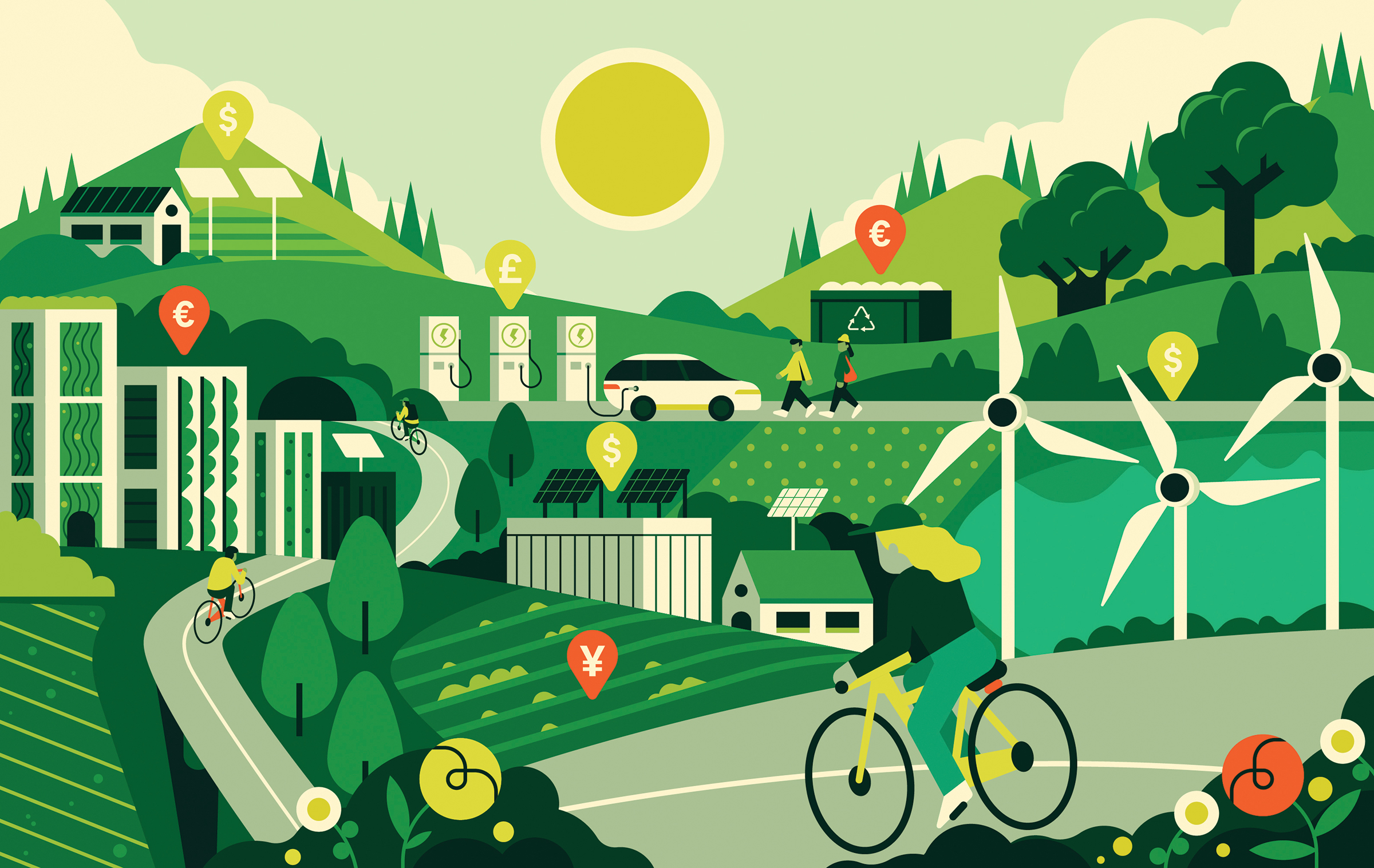As the climate crisis worsens, too many people are swinging from denial straight to despair. A few years ago, it was common to hear people deny climate change, downplay the enormousness of the threat, or argue that it is far too soon to worry about it. Now many people say it’s too late. The apocalypse is coming, and there is nothing we can do to prevent it.
Despair is as dangerous as denial. And it is equally false. Humanity has enormous resources under its command, and by applying them wisely, we can still prevent ecological cataclysm. But exactly how much would it cost to stop the apocalypse? If humankind wanted to prevent catastrophic climate change, how big a check would we have to write?
Naturally enough, no one knows for sure. My team and I have spent weeks poring over various reports and academic papers, living in a cloud of numbers. But while the models behind the numbers are dizzyingly complex, the bottom line should cheer us up. According to the International Energy Agency, achieving a net-zero carbon economy would require us to spend just 2% of annual global GDP over what we already do on our energy system. In a recent poll of climate economists conducted by Reuters, most agreed that getting to net zero would cost only 2% to 3% of annual global GDP. Other estimates put the cost of decarbonizing the economy a bit lower or a bit higher, but they are all in the low single digits of annual global GDP.
These numbers echo the assessment of the Intergovernmental Panel on Climate Change, which in its landmark 2018 report stated that in order to limit climate change to 1.5°C, annual investments in clean energy needed to increase to around 3% of global GDP. Since humankind already spends about 1% of annual global GDP on clean energy, we just need an extra 2% slice of the pie!
The above calculations focus on the cost of transforming the energy and transportation sectors, which are by far the most important. However, there are other sources of emissions as well, like land use, forestry and agriculture. You know, those infamous cow farts. The good news is that a lot of these emissions can be cut on the cheap through behavioral changes such as reducing meat and dairy consumption and relying more on a plant-based diet. It doesn’t cost anything to eat more veggies, and it can help you (and the rain forests) live longer.
Read more: Why We Must Revolutionize Food Systems to Save Our Planet
We can quibble endlessly about the numbers, tweaking the models this way and that. But we should look at the big picture beyond the math. The crucial news is that the price tag of preventing the apocalypse is in the low single digits of annual global GDP. It is certainly not 50% of annual global GDP, nor is it 15%. Rather, it is somewhere below 5%, perhaps as low as investing an additional 2% of global GDP in the right places.
And note the word investing. We aren’t talking about burning piles of banknotes in some huge sacrifice to the spirits of the earth. We are talking about making investments in new technologies and infrastructure, such as advanced batteries to store solar energy and updated power grids to distribute it. These investments will create numerous new jobs and economic opportunities, and are likely to be economically profitable in the long run in part by reducing health care expenditures and saving millions of people from sickness caused by air pollution. We can protect the most vulnerable populations from climate disasters, become better ancestors to future generations, and create a more prosperous economy in the process.
This wonderful piece of news has somehow been sidelined in the heated debate about climate change. We should bring it into focus, not merely in order to give people hope, but even more so because it can be translated into a concrete political plan of action. We have learned in recent years to define our goal in terms of one number: 1.5°C. We can define the means to do this with another number: 2%. Increase investment in eco-friendly technologies and infrastructure by 2 percentage points above 2020 levels.
Of course, unlike the 1.5°C figure, which is a scientifically robust threshold, the 2% figure represents only a rough guesstimate. It should be understood as a ballpark figure, helpful to frame the kind of political project humanity requires. It tells us that preventing catastrophic climate change is a totally feasible project, even though it would obviously cost a lot of money. Since global GDP is now about $85 trillion USD, 2% currently totals about $1.7 trillion. It means that to save the environment, we don’t need to completely derail the economy or abandon the achievements of modern civilization. We just need to get our priorities right.
Read more: Climate Crises Dominated 2021. But These Innovations Offer Some Hope
Signing a check for 2% of annual global GDP is far from the whole story. It won’t solve all our ecological problems, such as oceans brimming with plastic or the continued loss of biodiversity. And even to prevent catastrophic climate change, we’ll need to make sure that the funds are invested in the right places and that the new investments don’t cause their own negative ecological or social fallout. If we destroy ecosystems to mine for rare metals that are needed for the renewables industry, we might arguably lose as much as we gain. We will also need to change some of our behaviors and ways of thinking, from what we eat to how we travel. None of that will be easy. But that’s exactly why we have politicians—their job is to deal with the hard stuff.
Politicians are actually very skilled at shifting 2% of resources from here to there. It is what they do all the time. The difference between the policies of right-wing and left-wing parties often amount to a few percentage points of GDP. When faced by a major crisis, politicians swiftly shift far more resources to fight it. For example, in 1945, the U.S. spent about 36% of its GDP on winning the Second World War.
During the 2008–09 financial crisis, the U.S. government spent about 3.5% of GDP to save financial institutions deemed “too big to fail.” Maybe humankind should also treat the Amazon rain forest as “too big to fail”? Given the current price of rain-forest land in South America and the size of the Amazon rain forest, buying the whole of it in order to protect local forests, biodiversity and human communities from destructive business interests would cost about $800 billion, or a one-off payment of less than 1% of global GDP.
In just the first nine months of 2020, governments around the world announced stimulus measures worth nearly 14% of global GDP to deal with the COVID-19 pandemic. If citizens press them hard enough, politicians can do the same to deal with the ecological crisis. So can investment banks and pension funds. Pension funds hold about $56 trillion USD. What’s the point of having a pension if you don’t have a future?
At present, neither businesses nor governments are willing to make the additional 2% investment necessary to prevent catastrophic climate change. Where does the money go instead?
In 2020, governments expended $2 trillion USD on their militaries—that’s 2.4% of global GDP. Every two years, another 2.4% of global GDP is spent on food that goes to waste. Governments also spend about $500 billion annually on—wait for it—direct subsidies for fossil fuels! Which means that every 3½ years, governments write a nice fat check for an amount equivalent to 2% of annual global GDP, and gift it to the fossil-fuel industry. It gets worse. When you factor in the social and environmental costs that the fossil-fuel industry causes but isn’t asked to pay for, then the value of these subsidies actually reaches a staggering 7% of annual global GDP each year.
Now consider tax evasion. The E.U. estimates that money hidden by the wealthy in tax havens is worth around 10% of global GDP. Every year, another $1.4 trillion in profits is stashed offshore by corporations, which is equal to 1.6% of global GDP. To prevent the apocalypse, we’ll probably need to impose some new taxes. But why not start with collecting the old ones?
The money is there. Of course, collecting taxes, cutting military budgets, stopping food wastage and slashing subsidies is easier said than done, especially when faced by some of the most powerful lobbies in the world. But it doesn’t require a miracle. It just requires determined organization.
So we shouldn’t succumb to defeatism. Whenever someone says, “It’s too late! The apocalypse is upon us!,” reply, “Nah, we can stop it with just 2%.” And when COP27 convenes in November 2022 in Egypt, we should tell the assembled leaders that it is not enough to make vague future pledges about 1.5°C. We want them to take out their pens and sign a check for 2% of annual global GDP.

Harari is the author of Sapiens, Homo Deus and Sapiens: A Graphic History. Data sources for this article can be found on bit.ly/2-percent-more
- How Donald Trump Won
- The Best Inventions of 2024
- Why Sleep Is the Key to Living Longer
- Robert Zemeckis Just Wants to Move You
- How to Break 8 Toxic Communication Habits
- Nicola Coughlan Bet on Herself—And Won
- Why Vinegar Is So Good for You
- Meet TIME's Newest Class of Next Generation Leaders
